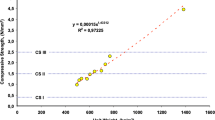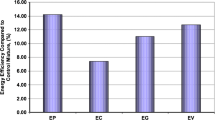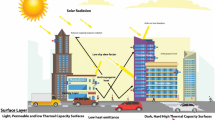Abstract
In recent years, thermal insulation and thermal comfort have gained great importance in buildings. Natural porous lightweight aggregates have a potential of greatly improvement on thermal insulation properties of cementitious products. However, its thermal insulation properties should not be evaluated solely with the thermal conductivity coefficient. This experimental study is devoted to determining the thermal comfort properties, namely thermal conductivity, thermal diffusivity, specific heat value, heat storage capability and heat storage efficiency of tested mortars for building applications. Within this scope, four different porous natural aggregate types were tested as lightweight aggregates for thermal insulation properties. These lightweight aggregates are pumice, volcanic slag, tuff and diatomite. The results show that the apparent porosities of the test specimens were quite high. As a result of this property, thermal conductivity values decreased considerably compared to the control specimen (up to 79.39%). Also, it is concluded that density and porosity ratio of the aggregate used in the preparation of the mortar specimens is an effective parameter on the specific heat of the material. The mortars produced by the volcanic slag, pumice, tuff and diatomite aggregates appear to be effective in heat storage. Additionally, it has been determined that the thermal characteristics of the materials change depending on the aggregate chemical structure. For this reason, the major chemical components of all mortar specimens were examined chemically, and the findings were tried to be associated with the thermal characteristics.









Similar content being viewed by others
References
Aruntaş HY (1996) Diatomit, özellikleri, kullanım alanları inşaat sektöründeki yeri. Cimento Ve Beton Dünyası 1(4):27–32
Bayraktar OY, Saglam-Citoglu G, Caglar H, Caglar A, Arslan M, Cetin M (2018) The mechanical properties of the different cooling requirements of high-temperature plaster. Fresenius Environ Bull 27(8):5399–5409
Bhattacharjee B, Krishnamoorthy S (2004) Permeable porosity and thermal conductivity of construction materials. J Mater Civ Eng 16(4):322–330
Bilgin F, Arıcı M (2017) Effect of phase change materials on time lag, decrement factor and heat-saving. Acta Phys Pol A 132(3):1102–1105
Brachaczek W (2019) Influence of cellulose ethers on the consistency, water retention and adhesion of renovating plasters. IOP Conf Ser Mater Sci Eng 471(3):32020
Cetin M (2015) Determining the bioclimatic comfort in Kastamonu City. Environ Monit Assess 187(10):1–10
Cetin M, Adiguzel F, Kaya O, Sahap A (2018) Mapping of bioclimatic comfort for potential planning using GIS in Aydin. Environ Dev Sustain 20(1):361–375
Chung O, Jeong S-G, Kim S (2015) Preparation of energy efficient paraffinic PCMs/expanded vermiculite and perlite composites for energy saving in buildings. Sol Energy Mater Sol Cells 137:107–112
De Schutter G, Taerwe L (1995) Specific heat and thermal diffusivity of hardening concrete. Mag Concr Res 47(172):203–208
Demirdag S, Gunduz L (2008) Strength properties of volcanic slag aggregate lightweight concrete for high performance masonry units. Constr Build Mater 22(3):135–142
Ercan T, Dinçel A, Metin S, Türkecan A, Günay E (1978) Uşak Yöresinin Neojen Havzaları Jeolojisi. Türkiye Jeoloji Kurumu Bülteni 21(2):104
Ercan T, Türkecan A, Dinçel A, Günay E (1983) Kula-Selendi (Manisa) dolaylarının jeolojisi. Jeoloji Mühendisliği 17:3–29
Gass IG, Smith PT, Wilson RCL (1971) Understanding the Earth. The MIT Press
González-Sánchez JF, Taşcı B, Fernández JM, Navarro-Blasco Í, Alvarez JI (2020) Combination of polymeric superplasticizers, water repellents and pozzolanic agents to improve air lime-based grouts for historic masonry repair. Polymers 12(4):887
Jasim MJ, Noh MZ, Zaidan SA, Ibrahim MHW, Durumin-Iya SG, Abdullah MM (2019) Thermal properties of concrete by replacement sand with porcelain waste. J Adv Res Fluid Mech Therm Sci 59(2):291–298
Jaskulski R, Dolny P, and Yakymechko Y (2021) Thermal and mechanical properties of lightweight concrete with waste copper slag as fine aggregate. Arch Civil Eng 67(3)
Kalkan SO, and Gündüz L (2016) A study on the usage of denim waste as reinforcement element in composite mortars on exterior building application. In: 12 International Congress on Advances in Civil Engineering, Istanbul, (pp 1–7)
Kalkan ŞO, Gündüz L, İsker AM (2021) A comparative analysis on the effects of pumice, tuff and conventional aggregates on energy efficiency performance in new generation composite mortars. Arab J Geosci 14(11):1–8
Khan ZAMAA, Abbas ZK (2021) Some properties of RCC containing silica sand powder exposed to MgSo4 solution. IOP Conf Ser Mater Sci Eng 1094(1):12051
Kilincarslan Ş, Davraz M, Akça M (2018) The effect of pumice as aggregate on the mechanical and thermal properties of foam concrete. Arab J Geosci 11(11):1–6
Koksal F, Gencel O, Kaya M (2015) Combined effect of silica fume and expanded vermiculite on properties of lightweight mortars at ambient and elevated temperatures. Constr Build Mater 88:175–187
Kumar A, Shukla SK (2015) A review on thermal energy storage unit for solar thermal power plant application. Energy Proc 74:462–469
Liew MS, Aswin M, Danyaro KU, Mohammed BS, Al-Yacouby AM (2020) Investigation of fibers reinforced engineered cementitious composites properties using quartz powder. Materials 13(11):2428
Lin R-S, Wang X-Y, Zhang G-Y (2018) Effects of quartz powder on the microstructure and key properties of cement paste. Sustainability 10(10):3369
Long L, Ye H (2016) The roles of thermal insulation and heat storage in the energy performance of the wall materials: a simulation study. Sci Rep 6(1):1–9
Mineral Commodity Summaries 2009. (2009). In Mineral Commodity Summaries. https://doi.org/10.3133/mineral2009
Mounir S, Maaloufa Y (2015) Thermal inertia for composite materials white cement-cork, cement mortar-cork, and plaster-cork. Energy Proc 74:991–999
Özbey G, Atamer N (1987) Kizelgur (Diatomit) Hakkında Bazı Bilgiler, 10. Türkiye Madencilik Bilimsel Teknik Kongresi, Ankara, pp 493–502. https://www.maden.org.tr/resimler/ekler/aeae10ea1c6433c_ek.pdf [in Turkish]
Pan J, Zou R, Jin F (2016) Experimental study on specific heat of concrete at high temperatures and its influence on thermal energy storage. Energies 10(1):33
Patural L, Marchal P, Govin A, Grosseau P, Ruot B, Deves O (2011) Cellulose ethers influence on water retention and consistency in cement-based mortars. Cem Concr Res 41(1):46–55
Poděbradská, J., Pavlík, J., Toman, J., & Černý, R. (2003). Specific heat capacity of cementitious composites in high-temperature range. In: Proceedings of the Thermophysics 2003 Meeting of the Thermophysical Society Working Group of the Slovak Physical Society, (pp 18–23)
Ribeiro DV, Labrincha JA, Morelli MR (2010) Use of red mud as addition for portland cement mortars. J Mater Sci Eng 4(8):1–8
Rittmann, A, and Rittmann L (1976) Volcanoes. Putnam. https://books.google.com.tr/books?id=Xl7wAAAAMAAJ
Shafigh P, Asadi I, Akhiani AR, Mahyuddin NB, Hashemi M (2020) Thermal properties of cement mortar with different mix proportions. Mater Constr 70(339):e224–e224
Shafigh P, Asadi I, Mahyuddin NB (2018) Concrete as a thermal mass material for building applications-a review. J Build Eng 19:14–25
Souza, A. T., Carvalhais, C. de A., & Santos, W. J. dos. (2021). Analysis of mortar coating with different types and proportions of chemical admixtures that have water retentivity properties. Revista IBRACON de Estruturas e Materiais 14
Spychał E, Czapik P (2021) The influence of cement type on the properties of plastering mortars modified with cellulose ether admixture. Materials 14(24):7634
Stolz HJ, Kehren G, Fluegel N (2019) Effects of oleochemical hydrophobing agents on plasters-results of a long-term field study. ZKG Int 72(9):61–67
Talebi HR, Kayan BA, Asadi I, Hassan Z (2020) Investigation of thermal properties of normal weight concrete for different strength classes. J Environ Treat Tech 8:908–914
Tang HJ (2021) Impact of Various Types Of Water Repellent Agent Towards Concrete Engineering Performance. UTAR, Malaysia
Tong, X. C. (2011). Characterization methodologies of thermal management materials. In Advanced materials for thermal management of electronic packaging Springer, New York, pp 59–129
Topay M, Parladir MO (2015) Suitability analysis for alternative tourism activities with the help of GIS: a case study of Isparta province. J Agric Sci 21(2):300–309
Topay M (2013) Mapping of thermal comfort for outdoor recreation planning using GIS: the case of Isparta Province (Turkey). Turk J Agric for 37(1):110–120
TS EN 998–1, (2017) Specification for mortar for masonry-Part 1: Rendering and plastering mortar
Turkish Standards Institution (2000) TS EN 1015–3-Methods of test for mortar for masonry- Part 3: Determination of consistence of fresh mortar (by flow table)
Turkish Standards Institution (2001) TS EN 1015–10, Methods of test for mortar for masonry-Part 10: Determination of dry bulk density of hardened mortar
Turkish Standards Institution (2010) TS EN 459–1-Building lime–Part 1: Definitions, specifications and conformity criteria
Turkish Standards Institution (2016). TS EN 13055-Lightweight aggregates
Wu MH, Ng TS, Skitmore MR (2016) Sustainable building envelope design by considering energy cost and occupant satisfaction. Energy Sustain Dev 31:118–129
Zhang J, Chen B, Yu F (2019) Preparation of EPS-based thermal insulation mortar with improved thermal and mechanical properties. J Mater Civ Eng 31(9):4019183
Zhang SP, Zong L (2014) Evaluation of relationship between water absorption and durability of concrete materials. Adv Mater Sci Eng 2014:1–8
Zhang W, Min H, Gu X, Xi Y, Xing Y (2015) Mesoscale model for thermal conductivity of concrete. Constr Build Mater 98:8–16
Author information
Authors and Affiliations
Corresponding authors
Rights and permissions
Springer Nature or its licensor holds exclusive rights to this article under a publishing agreement with the author(s) or other rightsholder(s); author self-archiving of the accepted manuscript version of this article is solely governed by the terms of such publishing agreement and applicable law.
About this article
Cite this article
GÜNDÜZ, L., Kalkan, Ş.O. The Effect of Different Natural Porous Aggregates on Thermal Characteristic Feature in Cementitious Lightweight Mortars for Sustainable Buildings. Iran J Sci Technol Trans Civ Eng 47, 843–861 (2023). https://doi.org/10.1007/s40996-022-00937-3
Received:
Accepted:
Published:
Issue Date:
DOI: https://doi.org/10.1007/s40996-022-00937-3




